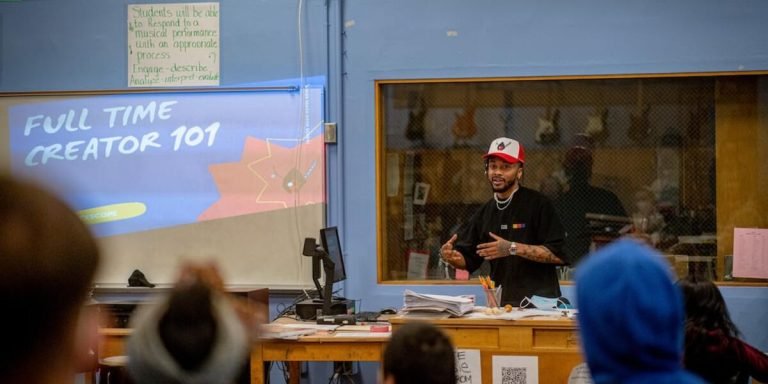Teacher to Teacher: Nurturing a Collaborative Environment in Education
In the realm of education, cultivating an environment where collaboration is valued and encouraged might be one of the most crucial aspects. The concept “teacher to teacher” not only signifies sharing knowledge but also represents a cooperative approach that can bring about better results for both educators and students alike. It promotes a culture where everyone learns from each other’s experiences—generating innovative teaching techniques in process.
The benefits extend beyond classrooms as well—they trickle down into homes, effectively engaging parents too. Involvement encourages parental support which is essential in reinforcing what has been learned at school while nurturing children’s self-esteem and ambition. This synergy between home-school learning dynamics fosters overall development paving way for successful future citizens.
Did you know?
Fact: According to a study published in “The Elementary School Journal,” teachers who established collaborative environments with their peers evidenced significant improvement in student achievement and classroom management.
Understanding the Role of Teacher-to-Teacher Support Networks
The intertwined network of teacher-to-teacher support plays a pivotal role in the ecosystem of childhood education. It fosters an environment where educators can learn, grow, and share their invaluable experiences with one another. In 2023 as digital platforms surge forward for connecting people worldwide, educator networks are no exception.
Online communities have become essential assets allowing teachers to stay connected beyond geographical boundaries.
Teacher-to-Teacher (T2T) Support Networks aren’t just about seeking advice or brainstorming ideas; they serve multiple purposes that often go unnoticed but significantly contribute towards overall educational progression. These platforms offer emotional sustenance during challenging times – adding resilience when dealing with individual teaching hurdles or institution-wide changes.
Benefits of Peer Collaboration in Education
Teacher-to-teacher support networks are no longer a luxury but have evolved into an essential component of today’s educational setting. The primary focus here is the immense benefits that come with peer collaboration in education.
Why should educators become part of these collaborative ecosystems? Consider the following benefits:
1. **Improves Quality Of Teaching**: Collaborative efforts like lesson planning or curriculum design help introduce varied perspectives towards handling classroom challenges thus fostering better quality teaching.
2. **Enhances Professional Development**: Peer mentoring programs within such networks provide unique opportunities for personal growth and professional development – be it adopting modern pedagogical techniques or incorporating technological advancements relevant to 2023.
3. **Promotes Emotional Well-being:** These communities serve as safe spaces for venting frustrations, sharing concerns and celebrating victories thereby improving morale among educators.
4. **Fosters Innovation In Pedagogy:** When teachers collaborate they exchange ideas leading to innovative approaches in delivering lessons suited best for their students’ needs.
Strategies for Building Effective Professional Learning Communities
Strategies for building effective professional learning communities can considerably impact the quality of education students receive. As parents and educators, it’s vital to comprehend these strategies as they facilitate “teacher-to-teacher” support networks that lead to a collaborative learning environment.
1. Foster Open Communication: Transparent communication amongst teachers is pivotal in constructing productive teacher-to-teacher relationships in 2023. Encourage open dialogues where ideas are shared fearlessly – good or bad.
2. Promote Shared Leadership: Rather than relying on an authoritarian style leadership, shared responsibility allows every teacher’s voice to be heard and valued within the network which could drastically improve overall team morale and productivity.
3.Facilitate Regular Meetings: Consistent interaction breeds familiarity – crucial for any supportive relationship structure. Maintain regular meetings (online or offline) among teachers; this would foster unity while providing opportunities for continuous professional development.
4.Encourage Peer Observation & Feedback: Teachers observing each other during classroom teaching sessions could prove highly beneficial due to diverse perspectives coming into play leading towards comprehensive feedback.
5.Incorporate Collaborative Problem-Solving Approach: Instead of dealing with pedagogical issues individually, adopt a collective problem-solving approach using brainstorming sessions thus leveraging everyone’s unique expertise enhancing results over time.
Enhancing Parent Engagement through Teacher-to-Teacher Communication
In this dynamic, tech-augmented world of 2023, a robust teacher-to-teacher communication system has become crucial for enhancing parent engagement. It’s not just about sharing students’ academic progress but also presenting insights into their overall well-being and development. A networked exchange among teachers across different spheres can foster deep understanding of student behavior, learning styles, achievements and challenges.
Such collective intelligence paves the way for personalized interventions to enrich each child’s educational journey. Moreover, it supports parents in balancing expectations with the realities of student performance – an imperative aspect contributing towards healthier home-learning environments. The consistency provided by synchronized information-sharing between teachers ensures that parents aren’t kept in obscurity concerning classroom activities or specific incidences pertaining to their children.
To further optimize these synergies within school communities – regular training sessions could be organized where experienced educators teach less seasoned staff effective strategies to observe learners holistically yet subtly; interpret findings accurately; maintain comprehensive records diligently and communicate effectively without overwhelming any stakeholder involved–including themself! Ultimately bolstering both teaching efficacy as well as meaningful parental involvement while promoting holistic childhood education.
Techniques for Fostering Strong Parent-Teacher Relationships
In the educational sphere, fostering strong parent-teacher relationships is a critical factor in enhancing student performance. This bond defines how well parents and teachers collaborate to ensure holistic growth for children.
Let’s explore techniques educators can use to strengthen communication with parents:
1. Regular Updates: Guaranteeing an update on students’ academic progression every week or month allows parents to be aware of their child’s advancement or areas needing improvement. Ensure these updates aren’t just about grades but also overall development.
2. Digital Communication Tools: Considering 2023, it’s high time we embrace digital tools like email newsletters, school apps etc., as they provide efficient ways for teacher-to-parent communications—send reminders about upcoming events and share photos from classroom activities using them.
5.Fostering Open Communication Channels: Establishing clear channels through which concerns are voiced promotes transparency –setting up anonymous suggestion boxes online could potentially encourage more feedback due lack fear judgement received during face-face encounters while maintaining privacy both parties involved respectively .
The Impact of Unified Educator Efforts on Student Success
In 2023, the educational landscape is undergoing significant shifts. Among these changes, the role of ‘teacher to teacher’ communication stands out as a pivotal factor in enhancing parent engagement and student success.
Unified educator efforts can have an immense impact on students’ academic achievements. When teachers collaborate effectively, they create a harmonious learning environment that fosters children’s growth and motivates them towards successful outcomes.
A consolidated approach among educators often leads to shared teaching strategies. These effective methods filter down into lessons and activities executed within classrooms which ultimately lead to better comprehension by students.
Streamlining Educator Resources with Teacher-to-Teacher Sharing Platforms
Thanks to technology and the internet, fostering strong communication between teachers is more feasible than ever. Teacher-to-teacher sharing platforms have emerged as a central online hub for educators worldwide. These well-curated education portals provide access to shared lesson plans, teaching strategies, learning materials and real-life success stories from peers in the industry.
The rise of teacher-to-teacher collaboration has proven to be an efficient way of streamlining resources while also boosting professional development among educators. Teachers can exchange practices that work perfectly with their audience or solicit advice for problematic areas they are facing during teachings. By embracing such interactive environments, there’s an ongoing loop of continuous learning where teachers grow together rather than separately.
For parents too – these platforms serve as invaluable resources; helping them gain deeper insight into contemporary educational methodologies being used at school level right now in 2023. This open-door policy not only breaks down barriers between home and schools but also fosters a holistic approach towards childhood education – enabling students to thrive both acadically and personally.
Leveraging Technology to Facilitate Resource Exchange Among Teachers
The digital era has undeniably revolutionized many spheres of life and the educational domain isn’t exempted. More than ever, it’s crucial to leverage technology as a valuable tool for streamlining educator resources, especially with teacher-to-teacher sharing platforms.
Teacher-to-teacher sharing is more than just exchanging teaching strategies; it also includes swapping lesson plans or classroom management hacks that have proven effective over time. Utilizing this method not only saves teachers precious time but can drastically improve students’ learning experience.
Technology comes in handy by offering numerous platforms designed specifically for such exchanges. Teachers across the globe can interact seamlessly at any given moment and share innovative approaches on how best to nurture young minds.
Online repositories present unlimited access to a vast range of materials suitable for different age groups, subjects, curriculum standards among other parameters. These databases are regularly updated ensuring teachers have fresh content available all year round – an extremely beneficial aspect in 2023 when education trends rapidly evolve due to globalization and digitization shifts in society (#21stCenturyEducation).
Additionally, social media groups offer another exciting avenue where educators connect directly through chats creating supportive professional communities committed towards improving their craft while ultimately enhancing pupil outcomes.
Besides resource exchange benefits like cost-saving and promoting effective pedagogical approaches , these platforms cultivate positive relationships amongst instructors fostering collaboration which plays an integral role upon individual success tied onto overall school performance scores & student achievements .
Promoting Continuous Professional Development Through Shared Expertise
As professional educators, it’s imperative we continually develop our abilities and practices. An increasingly popular venue for this growth is teacher-to-teacher sharing platforms. These online forums provide a space where teachers can exchange ideas, resources, strategies and even support each other through challenges specific to the education industry.
“Teacher to teacher” sharing platforms come with an array of benefits:
1) They promote continuous learning: With rapidly changing classroom dynamics in today’s digital age; there are always new things to learn as an educator – often from fellow professionals who’ve tackled similar issues or who possess expert knowledge in certain areas.
2) Save on time & resources: Sharing lesson plans or innovative teaching methods results in reduced planning time and increased efficiency for many teachers. Reading about others’ successful approaches could lead you straight towards effective solutions that have been tried-and-tested already!
3) Build community & improve morale: Teaching can sometimes feel isolating especially when dealing with unique student difficulties or institutional hurdles alone. Being part of these networking sites enables educators worldwide to share not just practical but emotional support — reducing overall stress levels whilst fostering sense of camaraderie within the profession.
Conclusion
Wrapping up, the potency of “teacher to teacher” collaboration in molding a more effective and responsive education environment is clear. The fertile exchange of ideas, best practices and deployment strategies not only enriches individual teachers but also paves ways for improved student outcomes. Remember – behind every successful learner are well-collaborated educators who understand that teaching is as much about listening and learning from each other as it is about imparting knowledge.
Our website exists with this very purpose – providing value-driven insights into various facets of children’s education while fostering an engaging community for parents and educators alike. So why stop here? Dive deep!
Explore our myriad resources tailored towards educating youngsters or delve into discussion forums rich with diverse parenting perspectives or educational strategies you could use in your classroom someday soon.







